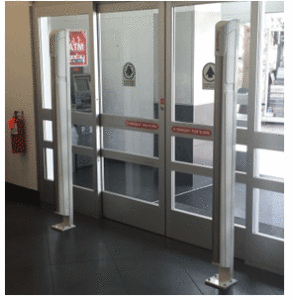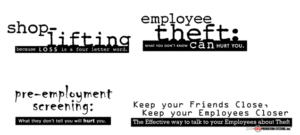Wine and liquor bottle security for grocery stores and alcohol beverage stores can be a difficult problem to address. According to the 2014-2015 Global Retail Theft Barometer report, in the Food and Beverages vertical rankings category, wines and spirits ranked number one both in North America AND Worldwide. The report states on page 55, “Products that are easy to steal, as well as easy to sell, are most prone to theft – resulting in high pilferage for items such as accessories, perfumes, and wines and spirits.” If you run a store that sells wine or alcohol you may be seeing empty shelves, but not from sales. Thieves could be targeting your merchandise if you aren’t protecting it. You may contend that you are protecting your merchandise because you are locking up your high dollar beverages. You might even argue that you are using bottle locks to secure merchandise higher than a specific price point. I would commend you on those efforts, but I believe you could do better. Shoplifters may be denied access to the expensive goods, but they will move to the cheaper items if they think no one is paying attention. A solution for protecting your lower-risk, lower end-merchandise is the Alpha Security Steel grip bottle cap.
The Steel Grip lock is an electronic article surveillance (EAS) device that is designed to provide bottle security for lower-risk wines and spirits. The lock has a metal strap that is secured around the lower portion of the bottle cap, tightening it around the neck of the bottle. While it does not protect the full cap like the other styles of bottle locks do, it does provide visual deterrence and EAS alarm protection if someone attempts to steal a bottle.
I have always been opposed to the merchandise protection strategy that sets a price point on merchandise before it is protected with some type of security device. As a former Loss Prevention Manager, I had to abide by similar guidelines and it annoyed me. In my opinion, this type of strategy is indicating there will be an acceptable level of loss. Here is what I mean, I walked into one grocery store and looked at their selection of wines. I tried to determine the price point that they were using before they implemented bottle security. It appeared the price of a bottle had to be around $29.99 or above before they used bottle locks to protect the merchandise. There were not a lot of selections at this price point, so that left a LOT of wine and champagne unprotected below that price. As a matter of fact, I would estimate over 95 percent of the merchandise in the department was NOT protected and therefore subject to theft. It might be irritating to a shoplifter to be prevented from stealing the higher priced bottle, but I can tell you from experience, they will be willing to settle for a $20 bottle if the $30 bottle is not available. Why is that loss acceptable to any store manager? That’s the message being sent.
The best strategy for improving profits and keeping store shelves in-stock for your legitimate customers is to protect all of the merchandise in a category of which you are concerned could be a target for theft. In a grocery store, squash and celery theft may not be a significant concern, but wine is (as indicated in the Global Retail Theft Barometer Report). Grocery managers should not worry about merchandise protection for veggies, but investing in Alpha Security bottle locks for all of the wine in the store could pay big dividends, especially if all the bottles are protected in some fashion.
Use Alpha Security full size bottle locks on your top shelf/ high ticket wines and spirits but don’t neglect the lower priced bottles. Use the Steel Grip bottle lock to deter ALL theft in your store and watch your profits grow.
Bottle Security is important and we can help you with it. Call 1.770.426.0547 and let’s talk.

 What is the solution to shoplifting and employee theft?
What is the solution to shoplifting and employee theft? Employee theft is a common and costly problem in retail. Some businesses’ are reporting that, for the first time, internal pilferage has now surpassed external. There are many ways to control and manage internal theft. But, one of the most effective ways is often overlooked. Stop it before it starts.
Employee theft is a common and costly problem in retail. Some businesses’ are reporting that, for the first time, internal pilferage has now surpassed external. There are many ways to control and manage internal theft. But, one of the most effective ways is often overlooked. Stop it before it starts. According to the National Retail Federation-
According to the National Retail Federation- Do you REALLY know how to stop shoplifters? I mean, really know? Your Checkpoint System is only half of the strategy. You spent the money, put the labor/time into using labels and tags but after the newness wears off, are you still having more losses than you want?
Do you REALLY know how to stop shoplifters? I mean, really know? Your Checkpoint System is only half of the strategy. You spent the money, put the labor/time into using labels and tags but after the newness wears off, are you still having more losses than you want?
 There’s been some news swirling around the LP world for a few weeks now about California and some new laws that the state has passed. Basically, the state raised the threshold for a felony theft to $950. The article hinted that shoplifting has increased in the major retail stores and calls for shoplifting cases have increased by 25% to the LAPD. The article blamed the new legislation for this. Here’s a link to that article if you’d like to read it. (
There’s been some news swirling around the LP world for a few weeks now about California and some new laws that the state has passed. Basically, the state raised the threshold for a felony theft to $950. The article hinted that shoplifting has increased in the major retail stores and calls for shoplifting cases have increased by 25% to the LAPD. The article blamed the new legislation for this. Here’s a link to that article if you’d like to read it. ( It’s no big secret that I can’t stand a thief; I did make a career out of catching them. Shoplifters really get under my skin, but employee theft really fires me up. You put people to work, give them opportunity to grow and instead of putting in the long hours, hard work and dedication needed to move forward, they steal from you. They betray your trust, slap you in the face and take money out of your pocket and food off your family’s table. Will you ever stop employee theft completely? Probably not. You can, however, minimize the risk.
It’s no big secret that I can’t stand a thief; I did make a career out of catching them. Shoplifters really get under my skin, but employee theft really fires me up. You put people to work, give them opportunity to grow and instead of putting in the long hours, hard work and dedication needed to move forward, they steal from you. They betray your trust, slap you in the face and take money out of your pocket and food off your family’s table. Will you ever stop employee theft completely? Probably not. You can, however, minimize the risk. Whether you’re a small one store business, or a large chain store, loss prevention awareness training for your teams cannot only protect against criminal acts, but also make a direct and positive impact on your bottom line. There is an inherent value in awareness training that lots of managers just don’t take advantage of. The core of any successful loss prevention program is not how many shoplifters are caught, nor is it how many employees were arrested; it’s training and awareness of your store teams. We are called loss “prevention,” not loss “reaction,” right? So how do you persuade your managers to see the value?
Whether you’re a small one store business, or a large chain store, loss prevention awareness training for your teams cannot only protect against criminal acts, but also make a direct and positive impact on your bottom line. There is an inherent value in awareness training that lots of managers just don’t take advantage of. The core of any successful loss prevention program is not how many shoplifters are caught, nor is it how many employees were arrested; it’s training and awareness of your store teams. We are called loss “prevention,” not loss “reaction,” right? So how do you persuade your managers to see the value?
